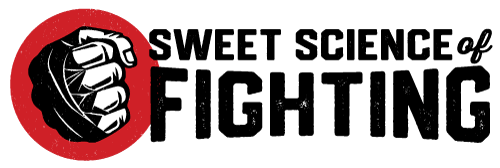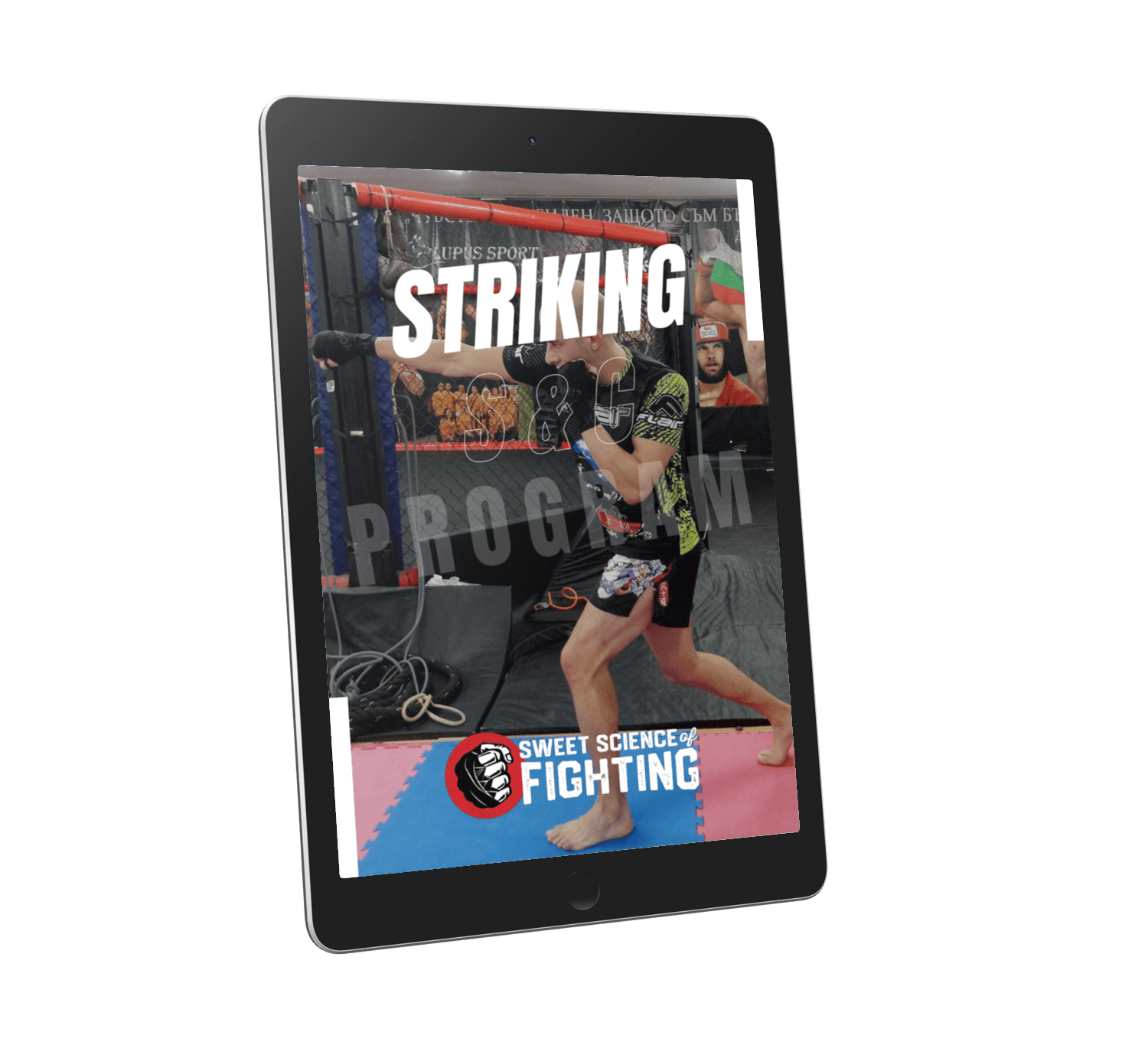While MMA is the ultimate clash of styles, stylistic rivalries are common amongst specialized combat styles. One of the fiercest rivalries in the striking domain is between Muay Thai and Dutch kickboxing.
The two styles have dominated the standup fighting world outside boxing for decades. But how do they match against each other?
Muay Thai is a separate combat sport coming out of Thailand, while Dutch kickboxing is a specific fighting and training method in Western kickboxing. Muay Thai is characterized by using all limbs as weapons and a heavy-kicking-oriented game, while Dutch kickboxing is best known for powerful boxing combinations and vicious low kicks.
Style vs. style comparisons often remain theoretical, but in the case of Muay Thai and Dutch kickboxing, we have plenty of real-life battles to draw our conclusions. Let’s see how they stack against each other and then look at legendary battles that shaped and defined this rivalry.
What Is Dutch Kickboxing?
Dutch kickboxing is an approach to kickboxing developed in the Netherlands and is so stereotypical that it’s considered a style of its own. Dutch kickboxing was heavily influenced by Kyokushin karate, Japanese kickboxing, and Muay Thai.
With all three styles leaving a mark, the strongest influence in Dutch kickboxing is Kyokushin, which can be noticed in the trademark aggression and fast pace of Dutch kickboxers.
The Dutch kickboxing style features high-volume attacks, predominantly punches, often finishing combinations with hard low kicks. Dutch fighters fight at a high pace and always try to maintain forward momentum and aggressive pressure.
The history of kickboxing in the Netherlands began in the 1970s when Dutch karatekas traveled to Japan and learned Kyokushin karate and Japanese kickboxing, which they brought back to their homeland.

How to Dominate Every Fight with Raw, Explosive Power No One Can Match
Discover the underground blueprint that has quietly turned MMA hopefuls into legends, using nothing but sheer, brute force and bulletproof conditioning techniques.
Muay Thai also impacted Dutch kickboxing’s development, but the core elements remain Western-style boxing combinations with knockdown karate aggression and kicking style.
The result of the development of kickboxing in Holland was more than impressive. During the golden age of kickboxing in the 1990s and 2000s, 15 of the 19 K1 World Grand Prix world champions were Dutch.
What Is Muay Thai?
The national sport of Thailand, Muay Thai, is a brutal striking sport characterized by punches, kicks, elbows, knees, and extensive clinching techniques.
The sport has developed throughout history and can be traced back to the 13th century. Like many other martial arts, it was born on the battlefield, but unlike most, it has not lost its edge and effectiveness in transitioning to the general population.
The contact with Western boxing changed the ancient martial art in Thailand at the beginning of the 20th century. By implementing the boxing ring, timed rounds, and boxing gloves (which replaced wrapping the hands with ropes) made the sport essentially what we know today.
Aside from the techniques and rules, a big difference between Muay Thai and other modern combat sports is the rich traditions Muay Thai is steeped in.
Every fight begins with a ritual dance called a Wai Kru. During the dance, fighters wear ceremonial headgear and armbands, and the accompanying traditional Sarama music does not stop even during the fights.
The global success and fame of Muay Thai came in the 1990s and 2000s when it clashed with the world of kickboxing. Many foreigners traveled to Thailand to fight at the local stadiums, and Thai fighters started fighting in K1, which popularized the style worldwide.
The rise of MMA further made Muay Thai more popular, as the style became the striking base of many MMA fighters.
Dutch Kickboxing vs. Muay Thai Key Differences
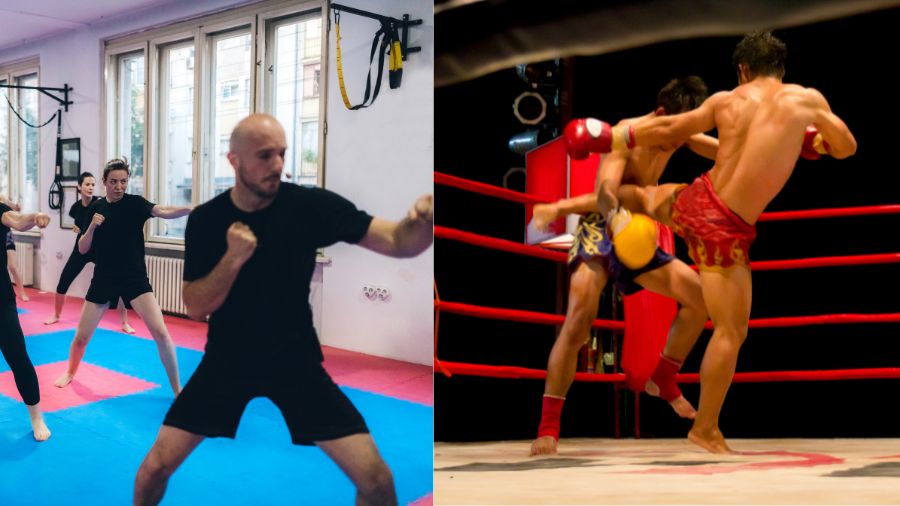
Rules
Muay Thai fights are fought in 5 rounds of 3 minutes each in a square boxing ring. Fights are scored as a whole, and each next round holds more significance than the previous one.
Strikes are allowed with every part of the limbs. Clinching is very important and allowed, as are trips, dumps, and throws (although not every kind of throw).
Dutch kickboxing is not a separate sport but a style within kickboxing, so we will cover the rules of K-1 style kickboxing used in all the major organizations in the world and the Netherlands.
Punches and kicks are allowed within this ruleset, while elbows are not. Knees can also be used, but not extensively in the clinch like in Muay Thai. Clinching is very limited and even banned in some organizations.
Kickboxing fights are scored round by round, like in boxing.
Techniques
Dutch kickboxers use punching techniques from boxing, with the addition of the back fist and Superman punch. High-volume power punching is synonymous with this kickboxing style.
Dutch fighters also have a specific way of kicking, especially the low kick. It’s a Kyokushin-style full-force kick coming across the thigh and landing with the shin.
Another staple of the style is the step-in knee and the jumping knee attacks, developed to land knees without the need for clinching.
Muay Thai fighters rely on punches sparingly and are often thrown as single strikes without much commitment. In close range and the clinch, Nak Muay uses elbows, which is one of the defining strikes in Muay Thai. Knees are also popular and used in various ways and purposes across all ranges.
Teeps are well utilized, but roundhouse kicks are what earn the most of the fearsome reputation of Thai fighters. The Thai way of kicking may not be the fastest or most precise, but it sure is the most powerful.
Another difference is how Dutch stylists and Thais block kicks. Thai fighters prefer to check all kicks except high kicks with their legs. Dutch kickboxers employ a double arm cross block that leaves the defender in a position to deliver a powerful counter punch.
Fight Pace
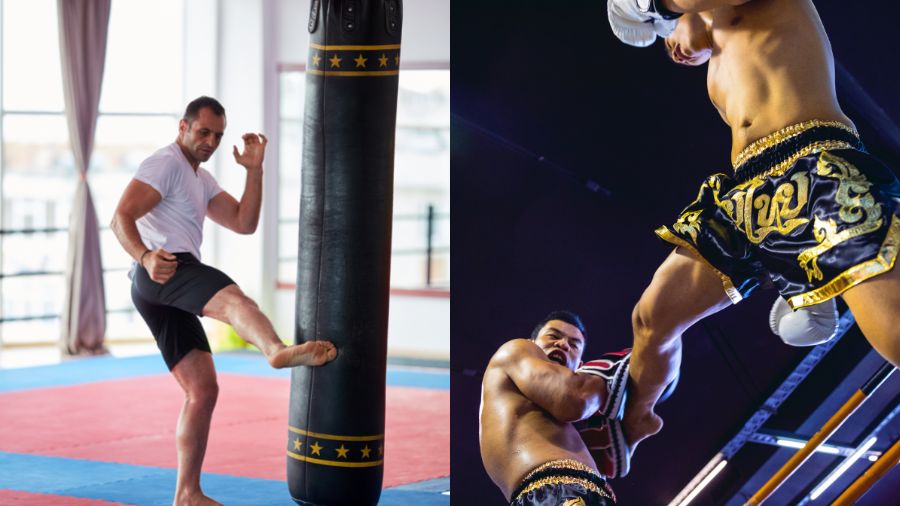
From the first moment you watch Muay Thai and kickboxing matches, you will see a stark contrast in pace. The K-1 kickboxing rules were created to guarantee entertaining and fast-paced fights. The Dutch kickboxers are masters at this game and push the pace from the first bell. Aggression and high volume are always desired and employed.
Thai fighters fight in a completely different way. The first round is always reserved for feeling things out between competitors and the crowd (bets are usually placed during the first round). The pace gradually builds as the fight progresses, with the last two rounds being the culmination of the fight.
Fighters mostly rely on powerful single strikes and well-timed counters. Of course, fighters like Saenchai and Samart Payakaroon break out of this model entirely. Still, the majority of the fights play out as described. On the flip side, modern top fighters like Rodtang fight much more like a Dutch stylist than a Thai.
Equipment
Because the two styles are so similar, the equipment required is almost the same, with the difference being more visual than practical. Here is what you will need to practice Muay Thai and Dutch kickboxing:
- Boxing gloves
- Shin guards
- Headgear
- Mouthguard
- Muay Thai shorts or Fight shorts
- Ankle supports
- Hand wraps
- Groin guard
Training
The Dutch and Thai training methods are also quite different. Reflective of their fighting style, Dutch kickboxers train at a high pace. They have used the give and take partner drills so extensively that they have generally become known as “Dutch kickboxing drills.”
This is a training method in which both trainees use their kickboxing gloves like pads and hold them for their partner to drill combos. The moment the sequence is finished, the other person repeats the combo. This way, there is no need for a trainer to hold pads, and everyone gets to work all the time.
Thai fighters mainly train on pads with an emphasis on power. The coach holds Thai-style pads (covering the forearm) and body shields. Trainers often wear Muay Thai shin guards and throw strikes to keep the fighter guessing. Each training session also includes clinch training.
Sparring etiquette also differs significantly. The Dutch have become famous for their hard sparring, almost resembling a fight. Nak Muay spar very lightly most of the time because they fight often.
They even have a word for the concept of relaxed sparring-Sabai. Both methods have benefits and drawbacks, but we will not dwell on them here.
Competitive Landscape
The availability of competitions for each style varies from country to country. Muay Thai has always been the strongest in its home in Thailand, where it’s a national sport. Elsewhere, there are many amateur competitions and clubs, but not the same level of professional fighting.
Kickboxing may have a more widely developed competitive landscape if we consider the whole world, but the sport has taken a back step to MMA in recent years. Nevertheless, organizations like Glory, One FC, K-1, and many others still provide a high-level proving ground and a viable pro career option.
Dutch Kickboxing vs. Muay Thai For Self Defense
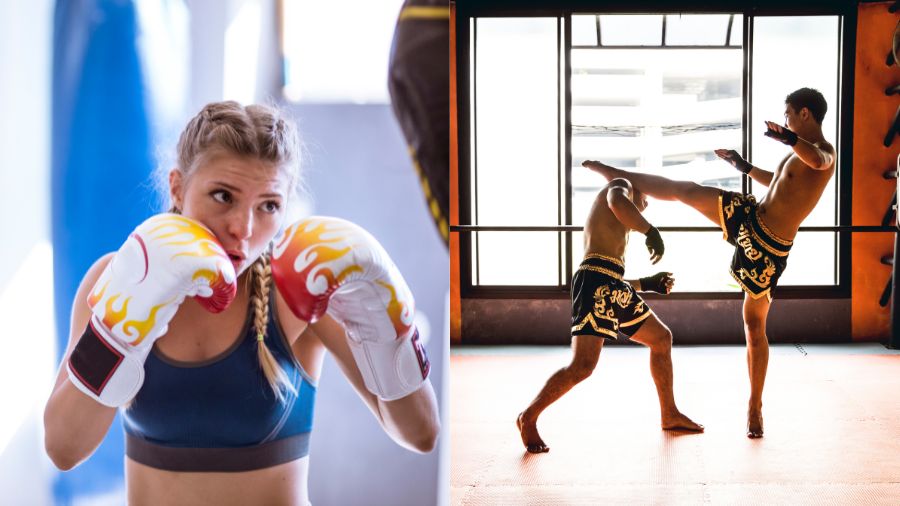
This will be a hard line to draw. Still, Muay Thai should have the edge based on the extended arsenal of weapons at its disposal, which includes elbows and, most importantly, clinch skills, which are invaluable in real-life situations.
But in reality, the way Dutch kickboxers fight might be better suited for real life. There is usually no time to gauge the opponent and settle into the fight in a street fight. A hard, fast, and aggressive approach is the best for self-defense, and this is precisely the method of Dutch kickboxing.
Dutch Kickboxing vs. Muay Thai For MMA
Both styles are excellent for MMA. Using knees, elbows, and clinching is a perfect lend in the cage, and Muay Thai has been the top choice for a striking art for countless MMA fighters.
Dutch kickboxing is also an excellent base for mixed martial arts. Where traditional Muay Thai lacks punching offense and defense, footwork patterns, and movement, kickboxers have a serious edge.
Of course, both styles need some work to work in the cage. The upright rear foot-heavy posture in Muay Thai makes it an easy target for wrestlers. And the complete lack of grappling in kickboxing means the kickboxer will have more skills to learn in the transition into MMA.
Dutch Kickboxing vs. Muay Thai – Who Would Win?
There is no need for me to answer the question, as countless field tests have been conducted worldwide. The stylistic rivalry began in 1982 when 4 Dutch fighters traveled to Thailand, and all four lost.
With these lessons learned and game plans adjusted, kickboxers like the legendary Ramon Deckers and Rob Kaman started beating Thais at their own game on their own turf.
Deckers became a Lumpinee stadium champion and a Thai celebrity, influencing the sport with his vicious punching combinations and proving some of the limitations of the traditional Thai style.
Then, a decade later, Buakaw exploded onto the scene and stormed the K-1 World Grand Prix, beating Dutch legends like Albert Kraus and Andy Sour in kickboxing rules.
The style battle continues today in arenas like One FC and Glory Kickboxing. New generations of Muay Thai fighters and Dutch kickboxers continue to battle for the supremacy of their style and fighting philosophy. A prime example of a more modern classic is the five fights between Marat Grigorian and Sitichai.
Dutch Kickboxing vs. Muay Thai – Which Should You Choose?
Both styles have much to offer, and it boils down, just like always, to personal preference. The accessibility of gyms in the region may well determine this preference. Some countries have a well-developed Muay Thai scene, while others have a better kickboxing one. Both have amateur ranks and serious possibilities for professional development at a world-class level.
Choose the one closest to your heart or closer to your home. If you have only one option, grab it without hesitation.
